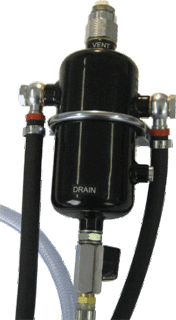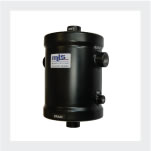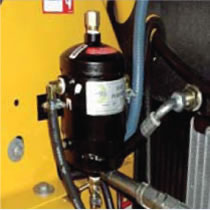MLS Diesel Fuel Purifiers

|
|
"Keeping your diesel fuel free from water and other contamination is fundamental to ensuring the life of the engine in your equipment."
Suitable for marine, agricultural, mining and plant hire applications. This product will extend filter life by 3 to 5 times, reducing maintenance costs and filter changes. Fuel can also be tested upon delivery for contamination.
Diesel bug (algae & bacteria) and dirt cause significant damage to engines resulting in costly repairs and down time. Filters are replaced more often. |
Order at bottom of this page
|
A Solution: When dirty or contaminated fuel enters the fuel purifier internal baffles immediately induce a spinning swirling action to the fuel, causing water, algae and solid contaminants to separate out move away from the fuel flow stream. This effect can be compared to debris such as logs and weed moving in a current towards the outside of a river's bend. Away from the main flow of fuel, the contaminants then fall to the base of the purifier where they are safely retained. These contaminants are then easily emptied.
How it works: The centrifugal force of the fuel spinning within the fuel purifier induces any particles that are heavier than the diesel to separate out. Although the fuel purifier is complex in its internal design, the process of separating particulates from the diesel is a simple process. |
Order at bottom of this page
|
|
|
|
Applications:
Please read the following application information bearing in mind that the MPS Fuel Purifier will remove 95% of contaminants and 100% of all water from diesel fuel and petrol. The information in each section is applicable to all application categories and should be read as a whole. There are three models of Fuel Purifier for engines ranging from 10 to 3000hp. |
|
Marine:
There are a few ways that boaters can reduce or stop water condensation in the tank:
Agricultural:
Most farms have fuel storage tanks which are filled periodically. While the issue of mechanically induced condensation is reduced in that hot fuel is not being returned to the fuel storage tank, condensation can occur where hot sunlight heats the tank before a cold night sets in. Given the distances and number of times it has been handled before it gets to the farm, agricultural fuel can often be of lesser quality or contain dirt particles. Many of these storage tanks are steel, which will form rust in the presence of water and air creating another type of diesel bug. The big question is how long has the fuel been stored and will it contaminate fresh fuel immediately?
Apart from considerations given above for marine applications, these storage tanks could also have insulation placed over them to reduce temperature changes.
Fuel could also be cycled daily using an electric fuel pump to ensure any water beads that had formed fell into the tanks water drain. Or the fuel could be cycled through the Fuel Purifier.
A filter could also be placed on the tanks outlet to ensure that fuel was as pure as possible before it leave the tank for the machinery its to power.
Mining:
Mining occurs in dusty environments often in remote areas. Both diesel bug and dirty fuel can be prevalent and the information provided above for the marine and agricultural sectors is valid. At issue are the vast distances to service and maintain machinery. Diesel bug or dirt may go unnoticed until such time as the remote equipment fails due to blocked filters or damaged injectors. How do you know if the fuel delivered to the work site is of good quality and free of contaminants?
The Purifier will immediately provide physical evidence of water and contaminants in newly delivered fuel.
Plant Hire Equipment:
How does a plant hire operator ensure that their customers' are using quality fuel in the expensive hire equipment? Many hire machinery breakdowns are caused by the customer cutting corners and adding poor quality dirty contaminated fuel to the machinery fuel tanks. There is no additive or filter that is going to reduce this risk as much as much as you would like.
The fuel purifier will remove 95% of contaminants and all water beads and is in operation with many plant hire businesses.
Bulk Fuel Storage & Distribution:
Mining and equipment companies often have large diesel storage tanks and distribute fuel from there to remote locations. Ensuring that the fuel arrives uncontaminated is a critical issue. Installing a fuel purifier at certain locations in the fuel distribution chain, can provide immediate, reliable and inexpensive "in the field" testing of fuel quality.
Installing a small pump in the loop allows fuel to be circulated within in the tank, continuously removing algae, dirt and water and reducing the tanks filter changes. Sensors can also be installed on the fuel purifiers to activate alarms or drainage solenoids at remote locations. |
Customer Views: "Grayline Coaches have found that fitting the MLS purifier has not only given us peace of mind on the quality of diesel our engines use, we have recorded lower exhaust emissions improving our green statistic for the environment."
"Rocket Rentals have fitted the MLS Fuel Purifier for nearly three years with excellent results. In the past month alone, the purifier has saved us two engines from serious failure and consequent cost." Simon Tomblin Managng Director Rocket Rentals Gloucester. |
Order at bottom of this page
|
Our solution: MLS Fuel Purifier
The MLS Fuel Purifier will remove water and solid particulates from even the dirtiest, most contaminated fuel. When used in conjunction with a conventional fuel water separator, they will work together to ensure that your engine is protected from harmful water and particles. The Fuel Purifier acts as the �first line of defence� removing water in suspension, rust, beads of water, dirt, sludge, algae bloom and grit allowing the filters to do their job more effectively. Fuel filters will last 3-5 times longer with the Fuel Purifier.
How to get the best quick results in a Diesel Bug environment: Carry out any of the remedial actions discussed above. Install the MLS Fuel Purifier into the fuel line before the primary fuel filter. Add a biocide to the tank, run the engine or fuel circulation pump. Check and empty the Fuel Purifier bowl regularly. Remember, any water beads forming in the fuel will immediately cause algae to start forming in the right conditions. As such you might consider running a fuel circulation pump during the night when temperatures start to fall and condensation occurs.
Understanding Diesel Bug:
There are several types of algae and bacteria commonly known as diesel bug. Testing the fuel can identify which bug is affecting the fuel supply. This can be helpful in determining how best to treat the tank and to take other remedial action.
Bio-Diesel and Water: Fuel legislation designed to reduce harmful emissions and increasing global demand for diesel has resulted in more and more bio-diesel finding its way into the fuel supply chain. The increased use of bio-diesel will increase the incidence of water contamination problems in diesel. Why? Bio-diesel contains more water than petro-diesel (it is introduced in the production process), it is also hygroscopic - it absorbs water from the atmosphere. Petro-diesel can absorb around 50 parts per million (ppm) of water whilst bio-diesel can absorb as much as 1500ppm � most global fuel standards recommend a maximum water content of 200ppm. As ambient temperatures rise water is absorbed into the fuel, as they fall the water condenses out of the fuel and forms free water at the bottom of fuel tanks. Free water can wreak havoc in your fuel system Poor fuel storage, bad fuel transfer and housekeeping practices, or simple human error, can easily result in water, sand, grit, rust etc in fuel, all of these can harm your engine. If you cannot be sure of the quality of the fuel going into your tractors, excavators, generators or pumps the engines that power them could be at risk and you could end up with expensive repairs and downtime.
By setting extra levels of protection on your vehicle or equipment you can reduce the risk of costly damage due to contaminated fuel. |
Order at bottom of this page
|
Model Sizes: Open links below to see what's in the box and instructions..............
MFP2: For engines with a fuel pump flow rate of up to 1.9 litres per minute. 10 day lead time. Maximum engine size of 150 HP. See manufacturers pump specification for confirmation. Dimensions MFP2� 70mm Dia. x 170mm long. 2.5KG. 10mm 3/8 banjo fitting with 8mm 5/16 reducers supplied. MFP6: For engines with a fuel pump flow rate of up to 6 litres per minute. In stock. Maximum engine size of 300 HP. See manufacturers pump specification for confirmation. Dimensions MFP6 � 115mm Dia. x 200mm long. 4KG. 10mm 3/8 banjo fitting with 8mm 5/16 reducers supplied. MFP10: For engines with a fuel pump flow rate of up to 10 litres per minute. 10 day lead time. Maximum engine size of 600 HP. See manufacturers pump specification for confirmation. Dimensions MFP10 � 115mm Dia. x 320mm long. 5KG. 10mm 3/8 banjo fitting with 8mm 5/16 reducers supplied. |
Page end. Use the breadcrumb at the top, or the left category column to navigate.


